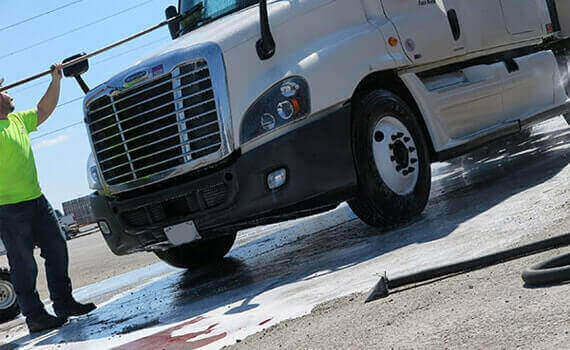
Before we discuss EPA regulations, we want to clearly state that ON-SITE, IN-POSITION/AS-PARKED FLEET VEHICLE WASHING IS LEGAL WHEN PERFORMED CORRECTLY BY A QUALIFIED CONTRACTOR SUCH AS QMI. If you have any questions or concerns about the washing of your fleet and staying in compliance with EPA regulations, please don’t hesitate to call us.
As you are aware, the discharge of storm water and other surface water run-off into the storm system has become an area of concern to many industries. The EPA has implemented regulations that affect your facility. We have been following these requirements as they have developed over the past decade.
The 1987 amendments to the Clean Water Act obligated the EPA to issue permits for storm water discharge. This permit is called the “National Pollutant Discharge Elimination System” (NPDES) permit and in many states is administered by state agencies such as the State Water Resources Control Board (State Water Board) in the state of California. In the State of California for example, the state has elected to obtain it’s own statewide general permit. In effect then, every business (public and private) in the state is covered under the State’s general NPDES permit and are obligated to comply with the requirements of the permit. The exceptions are those entities whose operations necessitate the need for an “individual” NPDES permit (city or county sanitation districts who discharge to U.S. bodies of water, for example). Since our methods yield zero-discharge to the storm system, our customers do not need an individual permit, so far as vehicle washing is concerned.
In our considerable experience in dealing with several county and city agencies, there are generally no local permitting requirements beyond the broader NPDES requirements that we are aware of. However, each city or county has the prerogative to implement additional requirements as they see fit.
The NPDES regulations involve surface discharges to the storm system from fleet activities and other industrial operations. Included within the NPDES regulations are references to specific pollutant limitations and quality standards for surface run-off entering the storm system. There are also suggested best management practices that involve the elimination or diversion of surface run-off before it can enter the storm system. Our methods are based on these suggested practices.
The main objectives of the NPDES permit program are twofold:
- To eliminate non-storm/non-rain discharges to the storm system. We need to consider all operations where the use of water is necessary and where this water may ultimately enter the storm system. Examples are truck washing, the cleaning of forklifts, containers, loading docks, etc. Such flows of water need to be collected and diverted in such a manner that prevents them from entering the storm system. Diverting such water flows to a clarifier, an oil and grit separator, or to the sanitary sewer are all potentially appropriate courses of action.
- To eliminate pollutants that may contaminate rain/storm water. You will need to consider those operations or conditions that result in pollutants ( chemicals, spoiled product, and other substances) that are exposed to rain, and may ultimately be washed down the storm system during a rain/storm condition. For example, if vehicles are serviced outside the building and fluids or other debris are left on the ground, these pollutants would eventually get washed into the storm system during a rain condition. Good housekeeping should eliminate such exposures.
As stated in the EPA’s manual, storm water management “…is a straightforward process that can be accomplished by facility managers and employees.” In reviewing our course of action in our proposal for services, you will see that managing the run-off from vehicle washing is in fact a very straightforward activity.
Please note that although we have consulted various public agencies and professional engineers specializing in this area, we do not warrant the accuracy or our opinions or conclusions. We encourage you to consult your company’s environmental staff or a professional consultant, if you have not already done so.
